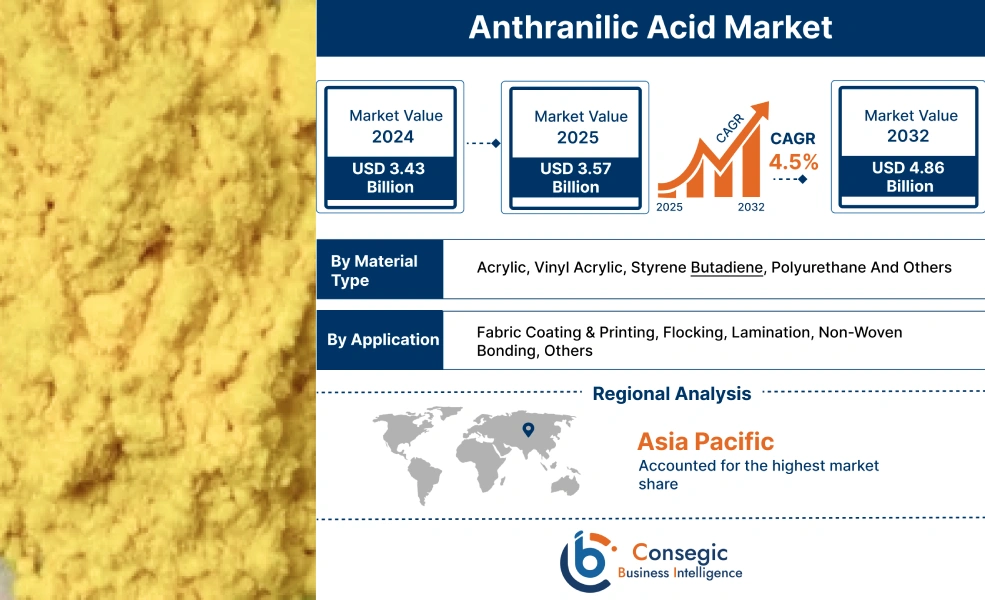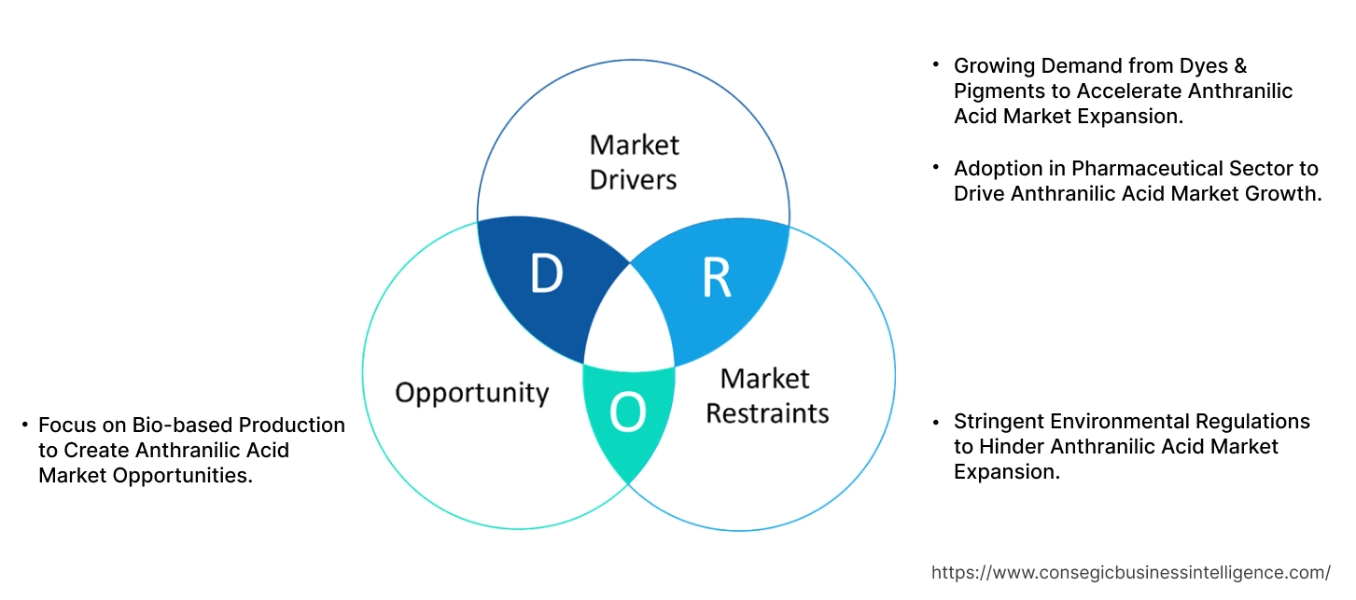Anthranilic Acid Market Size:
The Anthranilic Acid Market size is growing with a CAGR of 1.6% during the forecast period (2025-2032), and the market is projected to be valued at USD 147.91 Million by 2032 from USD 130.73 Million in 2024. Additionally, the market value for 2025 is attributed to USD 132.36 Million.
Anthranilic Acid Market Scope & Overview:
Anthranilic acid, also identified as aminobenzoic acid, is an organic compound characterized by the chemical formula C7H7NO2. It is an aromatic amino acid that features an amino group, and a carboxylic acid group positioned adjacently on a benzene ring. This compound appears as a white crystalline solid to pale yellow in commercial forms. It is distinguished by amphoteric properties due to its dual acidic and basic functionalities. Industrially, it serves as a vital chemical intermediate which is widely utilized in the production of diverse products such as pharmaceuticals, dyes, agrochemicals, and fragrances among others.
Anthranilic Acid Market Dynamics - (DRO) :
Key Drivers:
Growing Demand from Dyes & Pigments to Accelerate Anthranilic Acid Market Expansion.
Anthranilic acid serves as a key intermediate in the synthesis of various colorants, most notably azo dyes and anthraquinone dyes. These dyes are extensively used across numerous sectors, including textiles, leather, paints, coatings, among others. The continuous global demand for vibrant, long-lasting, and colorfast products in fashion, home furnishings, and industrial applications directly translates into a heightened need for the compound.
- For instance, according to the study, an estimated 800,000 tons of synthetic dyes are produced globally each year, with 3/4 of this volume being utilized by the textile sector.
Consequently, the reliance of the dye & pigments sector on the compound directly results in sustained need for the compound, propelling its market growth.
Adoption in Pharmaceutical Sector to Drive Anthranilic Acid Market Growth.
Anthranilic acid serves as a crucial compound for development, manufacturing, and research in pharmaceuticals. Specifically, it is used as a crucial chemical intermediate in the synthesis of a wide array of active pharmaceutical ingredients and various drug formulations. This includes widely used medications such as certain analgesics, anti-inflammatory drugs, and loop diuretics such as furosemide. The constantly expanding pharmaceutical landscape globally, fueled by continuous R&D, positively impacts market revenue.
- For instance, according to the analysis published by EFPIA, EU pharmaceutical R&D spending experienced an average annual growth of 4.4% between 2010 and 2022.
Thus, the growing adoption of the compound in pharmaceutical sector is driving the anthranilic acid market growth.
Key Restraints:
Stringent Environmental Regulations to Hinder Anthranilic Acid Market Expansion.
The anthranilic acid industry faces a significant constraint on its upward trajectory due to the increasing environmental concerns and stringent regulatory oversight of the chemical manufacturing processes involved in producing the compound that generate by-products and waste that require careful management and disposal. Regulatory bodies globally are increasingly imposing stricter limits on emissions, chemical waste, and water discharge from industrial facilities. Compliance with these evolving environmental standards necessitates substantial investments in advanced pollution control technologies, waste treatment systems, and process optimization. These increased operational costs and the potential for production limitations due to complex permitting processes hinder the profitability and scalability of the compound manufacturing, thereby restraining overall market growth.
Future Opportunities :
Focus on Bio-based Production to Create Anthranilic Acid Market Opportunities.
As industries worldwide seek greener alternatives, the development of this aminobenzoic acid from renewable biomass sources is gaining traction. This shift aligns with global environmental goals and consumer preferences for eco-friendly products. Bio-based production methods potentially reduce the carbon footprint, minimize hazardous waste, and offer a more sustainable supply chain. Companies investing in such innovative, bio-based synthesis pathways are contributing to a more sustainable chemical sector, thereby fostering market expansion.
- For instance, in 2024, Pili, a French company produced several tons of 100% biobased anthranilic acid through a robust, energy-efficient fermentation process utilizing non-food sugars enabling sustainable dye and pigment production.
As a result, as per analysis, the growing focus on biobased production methods benefits the anthranilic acid market analysis.
Anthranilic Acid Market Segmental Analysis :
By Grade:
Based on grade, the market is bifurcated into pharmaceutical grade and industrial grade.
Trends in the Grade
- Rising adoption of sustainable and eco-friendly production methods to align with global environmental regulations and consumer preferences is a key trend.
- Growing focus on traceability and quality assurance throughout the supply chain to ensure product integrity for pharmaceutical intermediates.
The industrial grade segment accounted for the largest anthranilic acid market share in 2024 and is expected to grow at the fastest CAGR over the forecast period.
- Industrial grade compound is manufactured to cater the purity, and specification demands of various industrial applications. Its purity levels, typically ranging from 95% to over 98%, are lower than those of pharmaceutical grade.
- Thus, offering a more cost-effective solution for large-scale industrial processes, this segment revenue is driven large scale use in production of azo dyes for textiles and paper as well as in the synthesis of pesticides and herbicides for agrochemicals.
- Furthermore, its esters are crucial for creating aromatic notes in fragrances and perfumes.
- The growth of this segment is predominantly driven by the expanding global textile, agriculture, and fragrance industries.
- For instance, according to FAO, global pesticide use in agriculture reached 3.70 million tons of active ingredients in 2022. This figure represents a 4% increase compared to 2021 and 13% rise over the decade.
- Furthermore, the increasing emphasis on these sectors on the adoption of biobased chemicals is influencing the industrial grade segment in the anthranilic acid market demand.
By Application:
Based on the application, the market is categorized into pharmaceutical intermediates, dyes & pigments, flavors & fragrances, agrochemicals, and others.
Trends in the Application:
- A rising shift towards eco-friendly and sustainable dye solutions where biobased solutions offer a greener alternative is a key trend.
- Focus on developing more effective and environmentally friendly pesticides and herbicides is a trend positively impacting the market.
The dyes & pigments segment accounted for the Anthranilic Acid market share of 39.56% in 2024.
- In dyes & pigments, this aminobenzoic acid serves as a vital intermediate in the production of azo dyes and various other pigments.
- The segment revenue is primarily fueled by the expanding textile and fashion industries across the globe. These sectors present the constant and increasing requirement for vibrant, durable, and diverse colors in clothing, home furnishings among others.
- In addition, growing in the paints and coatings sector also drives the adoption of this compound, as pigments are crucial for automotive, construction, and decorative applications, where aesthetics and performance are crucial.
- Furthermore, the rising emphasis on environmentally safer dyes is contributing to the segment's revenue aligning with global sustainability initiatives and consumer preferences.
- As a result, as per the anthranilic acid market analysis, the dyes & pigments segment is dominating the anthranilic acid market demand.
The agrochemicals segment is expected to grow at the fastest CAGR over the forecast period.
- In agrochemicals, anthranilic acid serves as a key intermediate in the synthesis of diverse pesticides, herbicides, and other essential crop protection chemicals.
- This application is driven by the escalating global imperative for increased food production and enhanced food security, necessitating higher crop yields.
- Furthermore, the rising incidence of crop diseases and pest threats globally creates the continuous necessity for advanced pest and disease control solutions.
- A growing emphasis on sustainable agricultural practices also contributes to segment turnover, as there is an increasing need for new agrochemical formulations that are both efficient and have lower environmental impacts.
- For instance, according to AgTech Media Group LLC, it is estimated that USD 260 billion will be invested for sustainable agriculture in developing economies by 2030.
- Hence, as per analysis, agrochemicals segment is growing at fastest rate in the upcoming years.
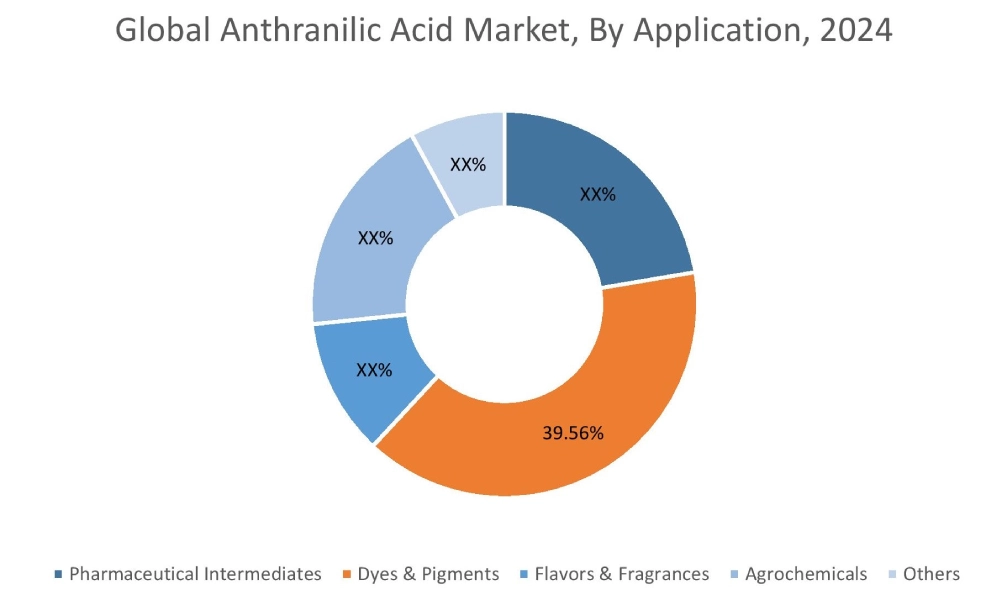
Regional Analysis:
The regional segment includes North America, Europe, Asia Pacific, the Middle East and Africa, and Latin America.
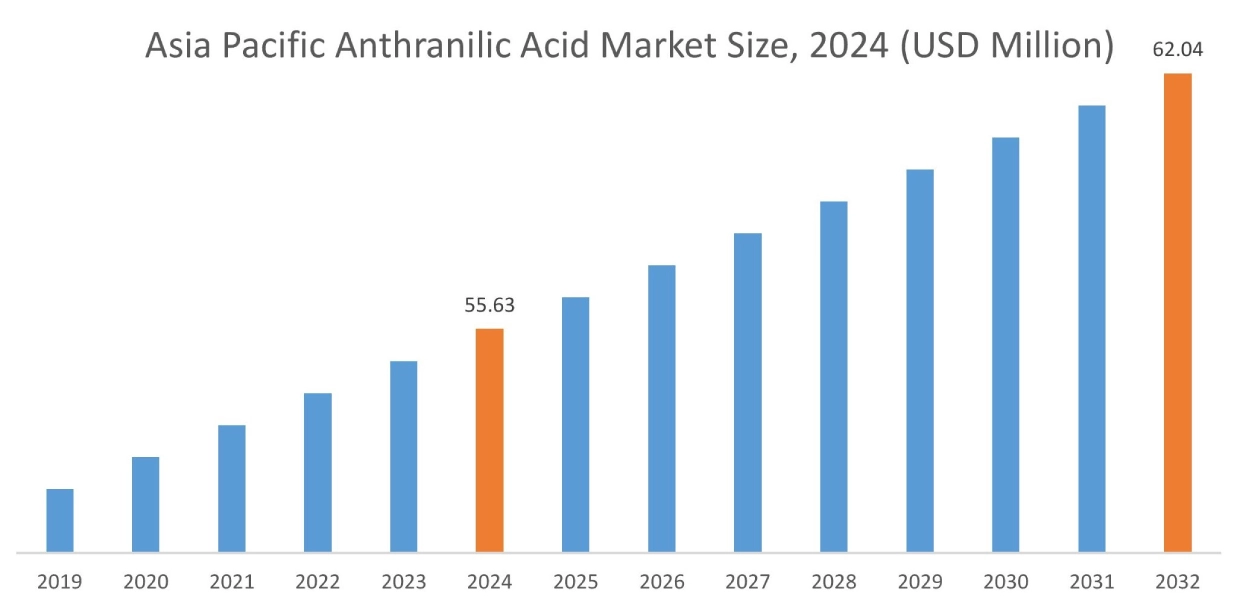
In 2024, Asia Pacific accounted for the highest market share at 42.55% and was valued at USD 55.63 Million and is expected to reach USD 62.04 Million in 2032. In Asia Pacific, China accounted for a market share of 39.23% during the base year of 2024. The Asia Pacific market demand is significantly defined by the increasing adoption in the dye and pigment sector as this aminobenzoic acid is a crucial intermediate for producing azo dyes which are widely used in textiles. Countries like China and India, with their massive textile manufacturing bases and booming fashion sectors, are major consumers of the compound for producing azo dyes and other coloring agents.
- For instance, according to Observatory of Economic Complexity, in 2025, China's textile exports experienced a notable increase, rising by 12.2% year-on-year.
This adoption in the production of dyes & pigments coupled with the strong manufacturing base of textiles, positions Asia Pacific as a significant market for the compound.
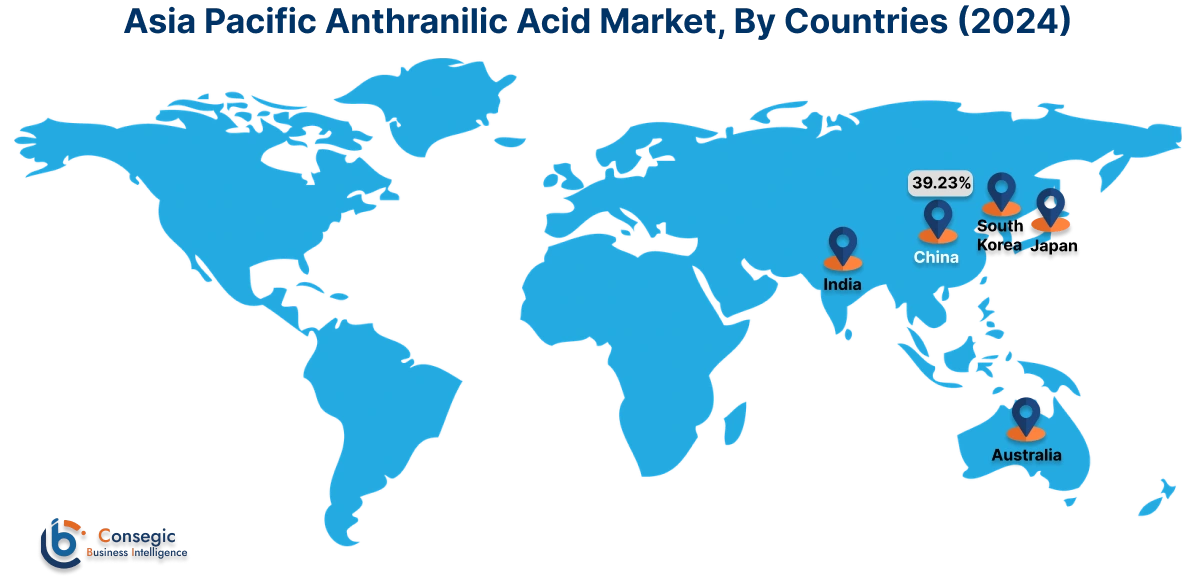
In Europe, the anthranilic acid industry is experiencing the fastest growth with a CAGR of 2.0% over the forecast period owing to growing emphasis on biobased production methods for the compound. Ambitious goals of the European Green Deal and stringent environmental regulations are influencing shifts from fossil fuel-derived chemicals to more sustainable alternatives. By prioritizing production methods that utilize non-food sugars and industrial fermentation, European manufacturers are not only meeting stringent environmental regulations but also supporting the growing necessity for more sustainable chemical ingredients across diverse industries. This strategic shift is creating new avenues for market trend within Europe's advanced chemical sector.
In North America market analysis, the region's robust pharmaceutical sector, characterized by extensive R&D and advanced manufacturing capabilities, drives substantial adoption of the compound in new drug formulations. The region's substantial investments in pharmaceutical research and development, coupled with increasing prevalence of chronic diseases, fuel the need for new and existing drug formulations. These factors collectively present a positive impact on the share of North American market trends.
The Latin American anthranilic acid market trend is primarily fueled by the expanding pharmaceutical and agrochemical sectors. The rising need for advanced healthcare, coupled with increasing investments in pharmaceutical R&D and manufacturing, drives the need for compound as a critical reagent. Simultaneously, the region's robust agricultural sector, aiming to boost productivity, utilizes the compound. As economies develop and regulatory frameworks for chemical safety become more stringent, Latin American countries are increasingly adopting this compound, further creating anthranilic acid market opportunities in the region.
The anthranilic acid market trend in the Middle East and Africa (MEA) is currently characterized by increasing investments in the region's pharmaceutical and chemical sectors, as well as a growing emphasis on enhancing agricultural output for food security. As these sectors develop, the adoption of the compound as a crucial intermediate in drug synthesis and agrochemical production is rising.
Top Key Players and Market Share Insights:
The Global Anthranilic Acid Market is highly competitive with major players providing products to the national and international markets. Key players are adopting several strategies in research and development (R&D) and product innovation to hold a strong position in the global Anthranilic Acid market. Key players in the Anthranilic Acid industry include:
- PILI (France)
- EMCO Dyestuff (India)
- Merck KGaA (Germany)
- Sandoo Pharmaceuticals and Chemicals Co.,Ltd. (China)
- HIMALAYA CHEMICALS (India)
- Honeywell International Inc. (U.S.)
- Shanghai Sunwise Chemical Co., Ltd (China)
- Thermo Fisher Scientific Inc. (U.S.)
Anthranilic Acid Market Report Insights :
| Report Attributes | Report Details |
| Study Timeline | 2019-2032 |
| Market Size in 2032 | USD 147.91 Million |
| CAGR (2025-2032) | 1.6% |
| By Grade |
|
| By Application |
|
| By Region |
|
| Key Players |
|
| North America | U.S. Canada Mexico |
| Europe | U.K. Germany France Spain Italy Russia Benelux Rest of Europe |
| APAC | China South Korea Japan India Australia ASEAN Rest of Asia-Pacific |
| Middle East and Africa | GCC Turkey South Africa Rest of MEA |
| LATAM | Brazil Argentina Chile Rest of LATAM |
| Report Coverage |
|
Key Questions Answered in the Report
What specific segmentation details are covered in the Anthranilic Acid market? +
By Grade and Application segmentation details are covered in the Anthranilic Acid market.
Which is the fastest-growing region in the Anthranilic Acid market? +
Europe is the fastest-growing region in the Anthranilic Acid market.
How big is the Anthranilic Acid market? +
In 2024, the Anthranilic Acid market is USD 130.73 Million.
Who are the major players in the Anthranilic Acid market? +
PILI (France), EMCO Dyestuff (India), Honeywell International Inc. (U.S.) are some of the major players in the market.
